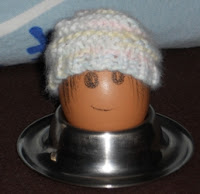"Zwei links, zwei rechts, zwei fallen lassen."
Just a cute name for this hat. When I first started seriously knitting, my mother would tell me that. It means "Two left, two right, drop two" in German. For simplicity purposes we shall call this hat "Men's Basketweave Beanie."
Materials
Yarn: Patons Classic Wool in Gray (about 1/2 skein)
Needles: US Size #8 (5mm) circular 16 inch needle and a set of Double Point needles
Crochet hook or tapestry/yarn needle
Pattern
Cast on 80 stitches.
Join row.
Rim:
(ROWS 1 THROUGH 8 ARE OPTIONAL, IF YOU WANT TO MAKE A FOLDED RIM FOR THE HAT)
1 - K2 P6, repeat 9 more times.
2 - K all.
3 - K2 P6, repeat 9 more times.
4 - K all.
5 - K2 P6, repeat 9 more times.
6 - K all.
7 - K2 P6, repeat 9 more times.
8 - P all.
9 - K2 P6, repeat 9 more times.
10 - K all.
11 - K2 P6, repeat 9 more times.
12 - K all.
13 - K2 P6, repeat 9 more times.
14 - K all.
15 - K2 P6, repeat 9 more times.
Increasing:
16 - K8, increase 1 by knitting into the stitch below, 10 times total.
(Total increase = 10 stitches = 90 total.)
17-22 - K2, P1, K5, P1; 10 times per round. (6 rounds total)
23-28 - K2 P7; 10 times per row. (6 rounds total)
29-34 - K2, P1, K5, P1; 10 times per round. (6 rounds total)
35-40 - K2 P7; 10 times per row. (6 rounds total)
41-46 - K2, P1, K5, P1; 10 times per round. (6 rounds total)
Begin decrease:
47 - K2, P7, and repeat 10 times per round.
48 - K2, P3, P2T, P2 and repeat 10 times per round. (80 stitches remaining)
49 - K2, P6, and repeat 10 times per round.
50 - K2, P2, P2T, P2, and repeat 10 times per round. (70 stitches remaining)
51 - K2, P5, and repeat 10 times per round.
52 - K2, P5, and repeat 10 times;
53 - K2, P1, K3, P1, and repeat 10 times.
54 - K2, P1, K2T, K1, P1, and repeat 10 times. (60 stitches remaining)
55 - K2, P1, K2, P1, and repeat 10 times.
56 - K2, P1, K2T, P1, and repeat 10 times. (50 stitches remaining)
57 - K2, P1, K1, P1, and repeat 10 times.
58 - K2, P1, K1, P1, and repeat 10 times;
59 - K2, P2T, P1, and repeat 10 times. (40 stitches remaining)
60 - K2, P2T, and repeat 10 times. (30 stitches remaining)
61 - K1, K2T, and repeat 10 times. (20 stitches remaining)
62 - K2T and repeat 10 times.
10 stitches remain. Cut your yarn and use tapestry needle/crochet hook to pull it through the loops and close off the hat.
You will notice that the rim of the hat folds halfway inward. Fold the whole thing together, and stitch it up, making a double reinforced rim. You can add elastic if you wish.
And, you're done!
















